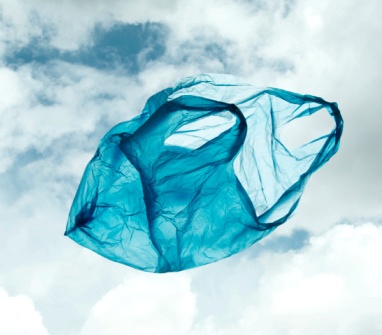Dec 26 - In Defense of the Plastic Bag...Ban
 Last week an article was written "In Defense of the Plastic Bag"--as if having millions of dollars of support and lobbying from the plastics industry to bully bag ban advocates was not enough for the ubiquitous plastic bag.
Last week an article was written "In Defense of the Plastic Bag"--as if having millions of dollars of support and lobbying from the plastics industry to bully bag ban advocates was not enough for the ubiquitous plastic bag.
While noting that the plastic bag issue was "complicated", the author also laid out his reasons for wanting to keep plastic bags.
Among them:
Studies say that plastic bags have a lighter environmental footprint than paper, and in some cases are preferable to reusable bags.
CAW’s response: First, consider that the amount of time a plastic bag is used by a consumer (roughly 12 minutes or less) is long outlasted by the amount of time it exists after being disposed of or littered in the environment (estimates of up to hundreds of years). Then consider that many of the studies comparing plastic and paper bags are written in geographical locations rendering them inapplicable to California. Assumptions made in those reports have led to incorrect assessments on factors such as greenhouse gas emission impact and recycled content in paper bags.
In today's market, with an enormous selection of available reusable and single-use bags that boggle the mind, consumers need to be aware of where different types of bags stand on the environmental impact hierarchy. The general rule should be that a recycled content reusable bag made as locally as possible would be better for the environment, especially as it keeps getting reused.
According to the life cycle assessment (LCA) conducted by California State University (CSU) Chico, reusable bags made from recycled polyethylene have a lower environmental footprint than plastic bags after as few as 8 uses. They use 50% less energy, have 40% less impact on greenhouse gas emissions and solid waste resources, and use 30% less water. Of course, increased reuse of these bags will provide even greater environmental benefit with up to 90% reduced impacts.
Some of the arguments put forth for the bans don’t hold up. That plastic…waste in the oceans you’ve probably read about? No, it’s not the size of Texas. Nor is it made of plastic bags.
CAW agrees that there have been some misunderstandings about the Garbage Patch. Likely, the varying estimates on the size of the Patch could all be accurate—depending on how the quantification measurement was taken. One generous measurement may have examined the surface area of the ocean containing plastic particles, while another more conservative measurement may have looked at how large the surface area would be if all the plastic particles were consolidated into one solid area.
To clear things up, the Garbage Patch is more likely a thin "soup" of plastic particles, including photodegraded plastic bags, rather than a recognizable floating island of trash in the middle of the Pacific Ocean . Though it may be hard to quantify, scientists who have been out to the gyre all agree that plastic pollutants are in the ocean and, while hard to clean, the pollutants need to be addressed because of the environmental impacts they have, both known and unknown.
Getting rid carryout bags won’t lead to a long-term solution to the problem of plastic waste. Maybe instead of banning or taxing bags, we should be recycling them. That’s the argument being put forth by a company called Hilex Poly, which will recycle tens of millions of pounds of plastic bags, sacks and wraps this year, and would like to do more.
Even when properly placed into a disposal or recycling bin, a plastic bag's unique ability to be airborne makes it easy to become litter. According to a 2011 CalRecycle report on plastic bag and film recycling collected in California stores, plastic carryout bags were recycled at a 3% rate in 2009. Despite establishing a statewide infrastructure for plastic bag recycling, recycling efforts have failed. Furthermore, the majority of comingled plastic collected for recycling was film and shrink wrap, at 63.2%. Only 5.9% of the plastic collected was actually plastic carryout bags.
Recycling isn't a solution, especially when recycled plastic bags can only be downgraded into a few limited, nonrecyclable products. A recycled content plastic bag can only contain up to 30% recycled content; the rest has to be virgin plastic according to plastic bag manufacturers.
Plastic pollution of the oceans probably isn’t as bad as you think.
Ever heard the phrase, out of sight, out of mind? Just because you don’t see the plastic that has either broken down into nearly invisible pieces or sunk to the bottom of the ocean doesn’t mean it’s not there and having an impact. Studies have shown that these plastic particles will actually attract and adsorb surrounding toxins, like DDE, PCBs, and other persistent organic pollutants. The potential for these plastic pieces to contaminate our food chain, as well as our water and soil quality, is immense.
Read more about common myths being perpetuated by the industry, and our responses, here.
CAW doesn't advocate for bans lightly, but because the plastic bag: a) poses a serious hazard to our environment and economy, b) is easily aerodynamic and difficult to properly dispose, and c) has a limited recycling market, we see no other viable solution to dealing with this problem.
You can stay up to date by signing up for email alerts and news. For more information, visit our Campaign to End Single-Use Plastic Bags. CAW is run on the generous support of our members. If you like our work, make a tax-deductible donation online today.
Better yet, take action and support single-use bag ordinances.
